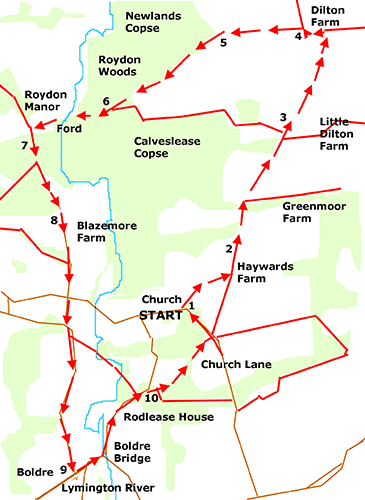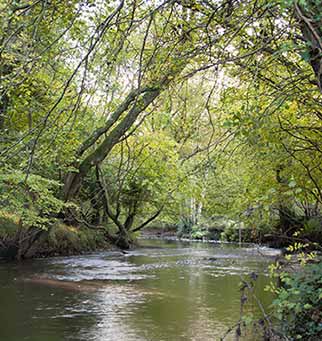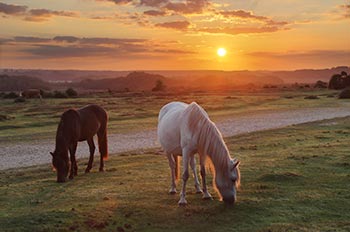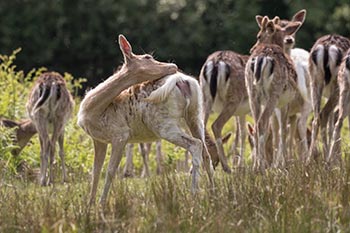A walk from Boldre
Entirely outside the New Forest perambulation, this is a very enjoyable walk of modest distance, and there is a pub on the route.
Passed along the way
Boldre Parish Church of St. John the Baptist; farmland around Boldre and Dilton; the Lymington River; Roydon Manor; Roydon Woods Nature Reserve; Boldre village and Boldre Bridge.
The route
Distance: 7 kilometres (4¼ miles). The route can also be extended to take in the Brockenhurst Park, Dilton and Ivy Wood walk, which adds a further 7 kilometres.
(Join the Brockenhurst walk route by turning right when just past Dilton Farm. Return to this route close to Roydon Manor. Check out the Brockenhurst walk map and all should be clear).
Start: Boldre parish church – SU323993.
Terrain: Mainly on level ground, but with a small number of gentle gradients. Mostly firm underfoot, but in winter and after rain, some sections can be wet and muddy. Strong, waterproof boots are therefore recommended.
Railway station: Brockenhurst – 5 kilometres (3 miles); Lymington, 5 kilometres.
Camping in the Forest camp sites: Hollands Wood, Brockenhurst, 6.5 kilometres (4 miles); Roundhill, 1.5 kilometres (1 mile) from the north-easterly section of the route.
Alternative starts: Roundhill camp site; and from limited roadside parking available by the crossroads to the west of Boldre church - at SU318994.

Directions

1. Park in Boldre parish church car park, and follow the public footpath leading away from the corner of the car park towards Haywards Farm. Reach the picturesque, part -thatched farmhouse and turn left along a well-compacted, well -hedged, gravel farm track.
2. Pass beside narrow bands of broad-leaved woodland on either side of the track; miss a turn on the right leading to Greenmoor Cottage and Farm, then another to Little Dilton Farm, and a public footpath on the left.
3. Follow the track over relatively open farmland to Dilton Farm. Immediately before the farm buildings, turn left along a grassy bridleway and follow this as it first goes 90 degrees right, then 90 degrees left.
4. Go through a gate and continue straight ahead, past a bridleway on the right, and along a wide, sometimes muddy, in places hedged track that unfortunately is partially edged by disused / discarded equipment and materials associated with the nearby farm.
5. Go through another gate into the Roydon Woods nature reserve, and follow the path as it goes through the edge of this magnificent broad-leaved woodland, here boasting mature oak trees and a tangled under-storey of overgrown, coppiced hazel. Pass a grassy ride on the right, and eventually leave the grasslands on the left to fully enter the wood, ignoring at this point a bridleway on the left.
6. Follow the way through the woods, downhill, past an often flooded pit amongst the trees on the left – Roydon brickworks was on the right down here.
Cross the Lymington River at a narrow footbridge; and continue ahead, half-left along a well-hedged track. (Roydon Manor can be seen on the right here).
Pass through two gates in quick succession, and immediately turn left at a ‘T’ junction.
7. Ignore a bridleway on the right, eventually leave the confines of the wood, and continue along a tree and hedge-flanked track with grasslands either side.
8. At the top of a short gradient, leave Roydon Woods Nature Reserve; join a narrow tarmac lane and continue downhill, past Blazemore Farm on the left, and Woodland Cottage on the right.
Reach a crossroads, and continue straight ahead along Royden Lane, following the sign for Boldre (½ mile) – note: there is limited alternative parking space here.
Ignore a lane on the right, then a public footpath on the left, and continue straight ahead. Notice on the right down here, Tidebrook Cottage with its initialed date-stone: HIB 1719.
9. Reach a ‘T’ junction with The Red Lion pub directly opposite, and turn left following the sign for Boldre Church and Beaulieu. Pass a delightful cluster of cottages – the one on the left has a barely legible 1786 date-stone - and cross the Lymington River at Boldre Bridge.
Turn left immediately, down Rodlease Lane, following the sign for Boldre Church – ¾ mile. Pass Rodlease House, a large, 3 storey Georgian residence, on the right; ignore a public footpath on the left; and then turn right along a public footpath opposite the entrance to Rodlease Farm, and immediately before a wholesale nursery business.
10. Pass a footpath on the right, and continue uphill beside broad-leaved woodlands. Turn left upon reaching a narrow lane, and Boldre Church is a short distance away on the right.
More links
Search this site
Sika deer continue to engage in rutting behaviour, and will do so until December.
Pigs seek out the remains of the acorn crop.
Beech leaves are transformed into a magnificent mosaic of glorious reds and golds. Other deciduous trees, too, take on an autumnal cloak before their leaves fall.
Dragonflies can occasionally be seen on the wing on bright days early in the month.
December
Foxglove leaves survive the winter at ground level, and offer the prospect of colourful summer blooms to come.
Redwings and fieldfares, autumn and winter visitors, gorge on haws and holly berries.
Great grey shrikes and hen harriers hunt over the heaths and other open spaces.
Honeysuckle by the end of the month often shows welcome signs of new growth.

Sadly, 58 animals were killed - 35 ponies, 13 cows, 8 donkeys and 2 sheep, whilst a further 32 were injured - 3 pigs, 9 donkeys, 11 cows and 9 ponies.
(Forty-three accidents occurred in daylight, 15 at twilight and 101 in the dark. Twenty-seven accidents were not reported by the driver involved).
Here's just one horrific example - Three donkeys killed in collision with van at notorious New Forest blackspot (Advertiser and Times)



